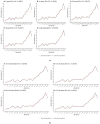Using Catalytic Models to Interpret Age-Stratified Lyme Borreliosis Seroprevalence Data: Can This Approach Help Provide Insight into the Full Extent of Human Infection Occurring at the Population Level?
- PMID: 39770840
- PMCID: PMC11678136
- DOI: 10.3390/microorganisms12122638
Using Catalytic Models to Interpret Age-Stratified Lyme Borreliosis Seroprevalence Data: Can This Approach Help Provide Insight into the Full Extent of Human Infection Occurring at the Population Level?
Abstract
Diagnosis of Lyme borreliosis (LB) is prone to under ascertainment with the true extent of infection unknown. Cross sectional age-stratified population-based serological survey data may provide insight into this issue. Using data from a previously published Dutch seroprevalence study, we describe the application of catalytic models to make estimates of the annual extent of LB infection. A common assumption when using catalytic models is that IgG is protective and immunity is lifelong. However, human IgG produced in response to natural LB infection does not protect against subsequent infection and its duration may be limited. Individuals were thus assumed to be continually susceptible to LB infection, with a range of scenarios used that varied the length of time that IgG may remain detectable, from 5 years post-infection to lifelong. The possibility that IgG may remain detectable for longer in adults than in children was also explored. Estimates for the annual number of LB infections occurring in the Dutch population ranged from 163,265 (95%CI 130,150-201,723) when assuming IgG remains detectable for only 5 years post-infection to 26,209 (95%CI 17,159-36,557) when assuming IgG is lifelong.
Keywords: Lyme borreliosis; catalytic models; infection; seroprevalence.
Conflict of interest statement
Both authors (A. Vyse and E. Colby) are employees of Pfizer which currently has a candidate vaccine against Lyme disease under development.
Figures



References
LinkOut - more resources
Full Text Sources

